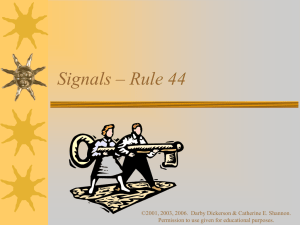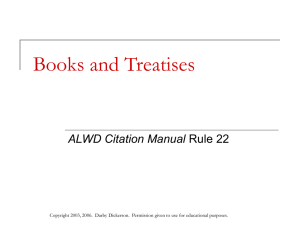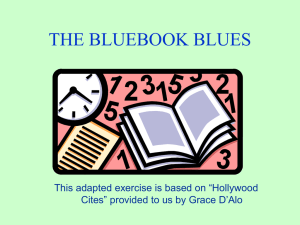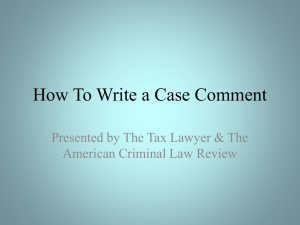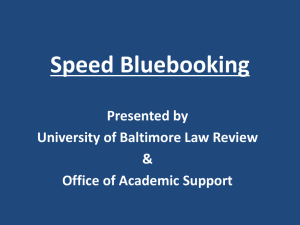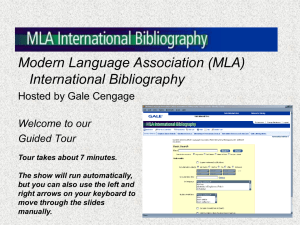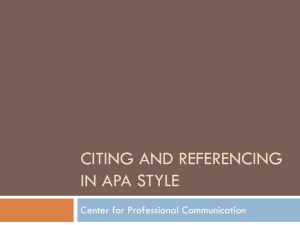Major Differences Between ALWD and Bluebook
advertisement
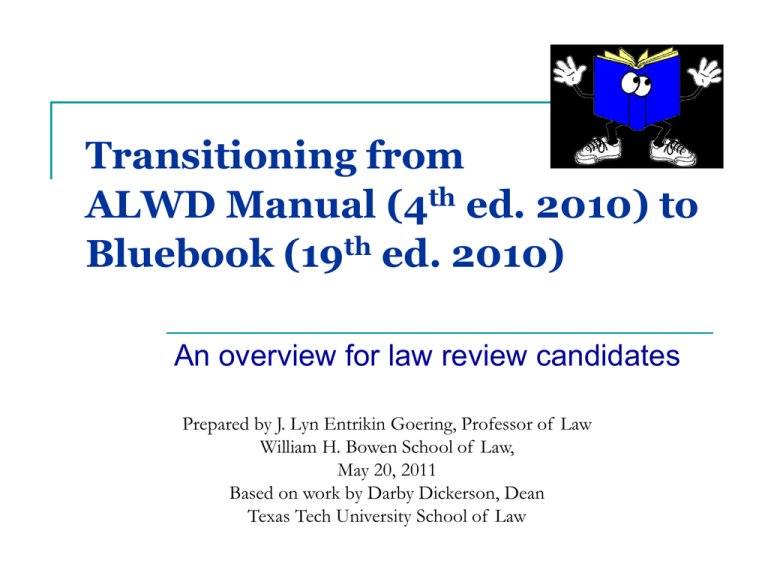
Transitioning from ALWD Manual (4th ed. 2010) to Bluebook (19th ed. 2010) An overview for law review candidates Prepared by J. Lyn Entrikin Goering, Professor of Law William H. Bowen School of Law, May 20, 2011 Based on work by Darby Dickerson, Dean Texas Tech University School of Law In other words . . . From This : To This: The [Evil] Bluebook Blues . . . Judge Richard A. Posner, Seventh Circuit Court of Appeals, recently published a book review (in The Yale Law Journal, of all places) of the most recent edition of the Bluebook: An unconscious awareness of the limitations of legal “science” drives the search for rigor into unlikely places, such as form of citations, and has given the profession a 511-page book that it does not need. Richard A. Posner, The Bluebook Blues, 150 YALE L. J. 850, 860-861 (2011) (footnote omitted). The [Evil] Bluebook Blues . . . Another author warns, If you have cracked open The Bluebook, you already know that it presents a bewildering assortment of rules, rules, and more rules for legal citation. If you are new to legal citation, or a little rusty at it, the task of deciphering and applying those rules can seem overwhelming. Linda J. Barris, UNDERSTANDING AND MASTERING THE BLUEBOOK: A GUIDE FOR STUDENTS AND PRACTITIONERS 3 (2d ed. 2010). The [Evil] Bluebook Blues . . . And yet another: The Bluebook is a thick book with a blue cover filled with more rules than the Internal Revenue Code. It is written by a consortium of law reviews and its primary purpose is as a money-making racket. Daniel Solove, Law Review Editing: Some Suggestions for Reform, Concurring Opinions, at http://www.concurringopinions.com/archives/2007/03/ some_pet_peeves.html (March 13, 2007). What’s the Difference, Anyway? Now in its 19th edition, the Bluebook was first published in 1926 by law review editors for law review contributors. Trivia Question: How long was the 1st edition? • As some commentators have observed, “The Bluebook is not user-friendly and was not designed as a teaching tool.” • Carol M. Bast & Susan Harrell, Has the Bluebook Met Its Match? The ALWD Citation Manual, 92 Law Library J. 339 (2000). What’s the Difference, Anyway? Originally, the Bluebook was never intended for use by practitioners. Yet recent editions include “blue pages” for preparing court pleadings, memos, and other practice-oriented documents (perhaps to compete with ALWD). For practice documents (legal memos, briefs, and other court pleadings), the differences are minor – in fact, nearly indistinguishable. But for scholarly writing, the critical distinction between the two citation manuals is the format for law review articles, especially footnotes. In law reviews, “all citations appear in footnotes appended to the portions of the text to which they refer.” BB Rule 1.1. That’s why law review writers need to know how to use the Bluebook – because most (not all) law reviews use it. General Tips for Using the Bluebook For footnote citations, consult Quick Reference: Law Review Footnotes (inside the front cover). Caution: The Quick Reference inside the back cover is for practitioner documents like memos and briefs, not law review articles. For text citations, consult BB Rule 1.1(a) and 2.2(a). As a general rule, all law journal citations belong in footnotes (except case names in text sentences, followed by a superscript footnote “call” number. [Create a footnote by placing the cursor where you want the call number, then clicking “references” and “insert footnote” from your word processing menu.] Use the Bluebook’s extensive index to find the pertinent rules. (Be sure you know how to use a print index – it’s not Google!) Significant Differences: ALWD v. BB 1. Typeface 2. Abbreviations 3. Books and Treatises 4. Legal periodicals 5. Footnotes 6. Signals 7. Order of Authorities 8. Other Minor Format Differences Typeface Conventions – Bluebook Rules 2.1 & 2.2 Law reviews generally use three kinds of typeface (dating to the typesetting days): Ordinary Roman type Italics SMALL AND LARGE CAPITALS Ordinary Roman type and Italics are used in both text and footnotes. SMALL AND LARGE CAPITALS are used only in footnotes. Typeface Conventions – Bluebook Rules 2.1 & 2.2 One major difference is that Bluebook footnotes use SMALL & LARGE CAPS for some citations. ALWD never uses small & large caps – whether in text or footnotes. For case names, the BB also differs in using italics, depending whether the case name is – (1) part of a text sentence (“textual citation”) or a stand-alone citation (“citation sentence”), and (2) in a full or short-form citation. Typeface Conventions – Cases Bluebook Rules 2.1 & 2.2 Textual Citations: While a case name is often mentioned in the main text of a law review article, such as Brown v. Board of Education,1 the rest of the citation appears only in the footnote (volume, reporter abbreviation, page, court abbreviation, and year), like this: 1 347 U.S. 483 (1954). Italicize the case name that stands alone in the main text. Remember not to abbreviate the case name in a text sentence, except the 8 magic words listed in Rule 10.2.1(c), mostly business designations: Co., Inc., Ass’n, Bros., Corp., Ltd., No., &. In the footnote, use ordinary typeface for the rest of the citation. Typeface Conventions – Cases Text Citations v. Citation Sentences: A text citation may also occur entirely in a footnote. If the case name and full citation are part of a footnote text sentence, or in other words “[w]hen a case name is grammatically part of the sentence in which it appears,” then italicize the full case name. Examples: 1 In Brown v. Board of Education, 347 U.S. 483 (1954), the Court rejected the “separate but equal” justification. Id. at 485. But don’t italicize if a case is cited only in a citation sentence: 1 The Supreme Court rejected the “separate but equal” justification in 1954. Brown v. Bd. of Educ., 347 U.S. 483, 485 (1954). Be sure to abbreviate in a footnote citation sentence (except 8 words listed in Rule 10.2.1(c), but do not abbreviate if the case is in a text sentence. See Table 6. Typeface Conventions – Cases Bluebook Rules 2.1 & 2.2 Footnote Citations: Full case citations. When citing a case2 in full in a footnote citation sentence (case name, volume, reporter abbreviation, page(s), court abbreviation, and year parenthetical): use ordinary Roman typeface for the full citation (except procedural phrases like In re), including the abbreviated case name. 2 Brown v. Bd. of Educ., 347 U.S. 483 (1954). Short-form case citations. When citing a case4 in short-form in a footnote (either a short-form case name, or the full case name with a short-form citation), italicize the case name (except procedural phrases like In re) and use ordinary Roman type for the rest of the citation information. 4 Brown, 347 U.S. at 485. Typeface – Other Authorities Bluebook Rules 11, 12, 13, 15, 16 In law review footnotes, use SMALL AND LARGE CAPITALS rather than ordinary typeface for citing the following in citation sentences and in full or short-form text citations: (1) (2) (3) (4) (5) (6) (7) (8) Book authors & titles: JOE T. GARCIA, BOOKENDS (2006). Periodical abbreviations (but not author names): ARK L. REV. Constitution names: CAL. CONST. Statute and Ordinance abbreviations: FLA. STAT. ANN. Restatements: RESTATEMENT (SECOND) OF TORTS Court rules: FED. R. CIV. P. Legislative reports and documents: H.R. REP. NO. Model and Uniform Acts: MODEL PENAL CODE Typeface – Other Authorities Bluebook Rules 2.2(a)(ii) But when referring to any of these sources by name in the text (without including the citation information), use the typeface appropriate for law review text (never large & small caps). Example: The library has a copy of The Path of the Law [book] that was published in the Harvard Law Review [law review], a complete set of the Federal Supplement [reporter], and today’s Wall Street Journal [newspaper]. It does not have a copy of Hearings on S. 776 [legislative document] or Alaska Statutes [statute]. Abbreviations - Bluebook Rule 6.1 The Bluebook and ALWD abbreviation spacing rules are virtually identical. But specific abbreviations differ. Bluebook (Table 6) uses some formats that include apostrophes (but no periods), while ALWD (App. 3) traditionally did not. But ALWD (4th edition) permits either abbreviation form: BB examples Comm’n Dep’t Env’t Int’l Nat’l ALWD examples Commn. or Comm’n Dept. or Dep’t Env. or Env’l Intl. or Int’l Natl. or Nat’l Abbreviations - Bluebook Rule 6.1 While most ALWD abbreviations are in Appendix 3, the Bluebook has separate abbreviation tables for different purposes. In general, the Bluebook allows fewer general abbreviations). Be sure to use the correct table! Bluebook Table T.6 - Case Names (other than textual cites) T.7 - Court Names T.8 - Explanatory Phrases T.9 - Legislative Documents T.10 - Geographical Terms T.11 - Judges and Officials T.12 – Months T.13 - Periodicals T.14 - Publishing terms T.15 - Looseleaf Services, etc. T.16 - Subdivisions Example Brown v. Bd. of Educ. Jud. Dist. cert. denied, H. Rep. Ark., Chi., Czech Rep. J., Sen., Comm’r Jan., Aug. Ark. L. Rev. ed., vol., unabr. U.C.C. Rep. Serv. (CBC) supp., vol., nn. Books and Treatises - BB Rule 15 Key Differences from ALWD Manual Typeface. Bluebook Rule 15.3 requires SMALL & LARGE CAPS for the author’s name and the book’s title. JOHN G. AUTHOR, BOOK TITLE 25 (2d ed. 2009). Volume Number. Bluebook Rules 3.1 & 15.1 require a different format to designate the volume number of a multi-volume work. The volume number immediately precedes the author’s name. 2 FREDERICK POLLOCK & FREDERIC WILLIAM MAITLAND, THE HISTORY OF ENGLISH LAW 205-06 (2d ed. 1911). Publisher Name. Bluebook citations do not include names of book publishers (unless citing a work published by a different publisher than the original one) but do include names of editors or translators. See Rules 15.2 & 15.4(iii). Annotations: Bluebook Rule 16.7.6 The Bluebook requires addition of the word “Annotation,” in ordinary Roman typeface, after the author’s name and before the title of the annotation: William B. Johnson, Annotation, Use of Plea Bargain or Grant of Immunity as Improper Vouching for Credibility of Witness in Federal Cases, 76 A.L.R. FED. 409 (1986). Note that the abbreviated title of the volume is in large and small caps. Periodicals: Bluebook Table 13 A few periodical abbreviations differ between ALWD and the Bluebook. Look up each one in Bluebook Table 13 to ensure accuracy. Examples: ALWD ABA J. J. Leg. Educ. J.L. Socy. Intl. Law. J. Intl. Wildlife L. & Policy L. & Socy. Rev. Bluebook A.B.A. J. J. LEGAL EDUC. J.L. SOC’Y INT’L LAW. J. INT’L WILDLIFE L. & POL’Y L. & SOC’Y REV. Periodicals – Bluebook Rule 16 The Bluebook format for citing periodicals that are not consecutively paginated differs slightly from ALWD: Bluebook Rule 16.5: Eileen Libby, A Qualified Yes, 94 A.B.A. J., Nov. 2008, at 32. ALWD Rule 23.1(f)(3): Eileen Libby, A Qualified Yes, 94 ABA J. 32 (Nov. 2008). Footnote References – Bluebook Rule 3.2(b) The Bluebook requires a slightly different format than ALWD when citing to footnotes: Bluebook (no space between “n.” and number): Chevron U.S.A. v. Nat’l Resources Defense Council, 467 U.S. 837 n.9 (1984). ALWD (add a space between “n.” and number): Chevron U.S.A. v. Nat’l Resources Defense Council, 467 U.S. 837 n. 9 (1984). Footnote References – Bluebook Rule 4.2(a). The Bluebook requires a slightly different format than ALWD when using supra or infra to crossrefer to other internal footnotes: Bluebook: See Reich, supra note 9, at 18. ALWD (Rule 10.3(a)): See Reich, supra n. 9, at 18. Note: Unlike ALWD, Bluebook Rule 15.10 does not permit the use of infra to cross-refer to books, reports, or other nonperiodic materials cited later in a work. Signals: Bluebook Rule 1.2(a) While Bluebook rules for signals are similar to ALWD rules, note the minor differences: (1) After E.g., add a unitalicized comma. If e.g. is used with another signal, add an italicized comma before and an unitalicized comma after the “e.g.” signal: See, e.g., Brown v. Bd. of Educ., 347 U.S. 483 (1954). ALWD Rule 44.6(a) omits both commas. Signals: Bluebook Rule 1.3 While Bluebook rules for signals are similar to ALWD rules, note the minor differences: (2) In a string citation, group each major category of signals (support, comparison, contradiction, background) in separate citation sentences, each ending with a period. Begin the next group with a capital letter. Bluebook: See Case A; Case B. But see Case D. See generally Case G. ALWD R. 44.8(c): See Case A; Case B; but see Case D; see generally Case G. Signals: Bluebook Rule 1.3 (3) The order in which signals are grouped in a citation sentence differs slightly in the Bluebook rules from the order required by the ALWD manual. Use the following order for Bluebook: (1) Suggesting support: [No Signal], Accord, See, See also, cf. (2) Suggesting comparison: Compare . . . [and] . . . [with] . . . and . . . . (3) Suggesting contradiction: Contra, But see, But cf. (4) Suggesting background material: See generally (5) The sequence for “e.g.” citations depends on the signal it accompanies (including “No signal”). Signals: Order of Authorities Bluebook Rule 1.4 Federal district courts: The Bluebook rule treats federal district court decisions as if they are issued by a single court. Within each signal, put the opinions in reverse chronological order, ignoring the federal district name. In comparison, ALWD Rule 45.3(f) treats each federal district as a distinct court, ordering decisions alphabetically -- first by state, then by district -- and within each district, in reverse chronological order. Order of Authorities Within Signals: Bluebook Rule 1.4 Federal courts of appeals: The Bluebook treats them as one court. Simply put the decisions in reverse chronological order, without regard to circuit number. In comparison, ALWD Rule 45.3(f) treats federal circuit courts as distinct courts, ordering their decisions by circuit ordinal (First, Second, and so forth), followed by the D.C. Circuit and finally the Federal Circuit. Within each circuit, the cases are cited in reverse chronological order. Other Minor Format Differences Related authority Page spans Internal cross-references Short-form case citations in footnotes Long quotations Capitalization of “court” Intermediate state appellate court cases Multiple decisions issued the same year Cases in electronic data bases Related Authority: Bluebook Rule 1.6 & Table 8 The Bluebook generally requires adding an italicized explanatory phrase to a citation to append related authority that refers to the cited authority. See Table 8 for abbreviations. Filled Milk Act § 1, construed in Milnot Co. v. Richardson, 350 F. Supp. 221 (S.D. Ill. 1972). ALWD Rule 46.4 generally places similar references to cited authority in explanatory parentheticals using ordinary type. Related Authority: Bluebook Rule 1.5 But if a primary authority discusses, quotes, cites, or otherwise mentions another source, then include that reference in an explanatory parenthetical using ordinary typeface: Case A (citing Fla. Stat. Ann. with approval). ADA Amendments of 2008 (explicitly overruling Case A). Page Spans: Bluebook Rule 3.2(a) Unlike ALWD, which gives some flexibility on citing a span of pages, the Bluebook is very specific. Drop any repetitious digits, but in any case always retain two digits on the right side of the hyphen. Separate the page numbers with an en dash (–) or hyphen (-). Examples: 87 Yale L.J. at 1354–57 [not 1354-1357 or 1354-357] 87 Yale L.J. at 101-05 [not 101-105 or 101-5] The page span rule does not apply to section or paragraph numbers. BB Rule 3.3(b) allows omission of identical digits or letters preceding a punctuation mark, unless doing so would create confusion. Otherwise retain all digits. Example: Del. Code Ann. tit. 9, §§ 817–819 (1989). Internal Cross-References: Bluebook Rule 3.5 The rules are very similar, but under the Bluebook, spell out “note” or “part” rather than abbreviating those subdivision names: Bluebook: Supra note 45 and accompanying text. ALWD: Supra n. 45 and accompanying text. Short-Form Case Citations Bluebook Rule 10.9 The rules are very similar, but the Bluebook has a rule for footnotes that ALWD does not: A short-form citation to a case may be used “if it clearly identifies a case” previously cited - in the same footnote, or “(either in full or short form, including “id.”) in one of the preceding five footnotes.” Rule 10.9(a) (emphasis in original). The 19th edition relaxes the 18th edition’s rule discouraging more than five sequential “id.” citations, but use caution! Long Quotations–Bluebook Rule 5.1 Bluebook Rule 5(a)(i) requires a block indent (both left and right margins) whenever quoting fifty or more words. ALWD Rule 47.5 requires a block indent whenever the quotation – spans more than four lines of text or includes fifty or more words. Capitalization – Bluebook Rule 8 Most capitalization rules are consistent. Two Bluebook differences: Generally do not capitalize prepositions. Rule 8(a). Exceptions: Prepositions five or more letters long; [Until, Within, Under] Prepositions that begin a heading or title; Prepositions immediately follow a colon. Do not capitalize the word “court” when referring to a state supreme court, except when naming the court in full. Rule 8(b)(ii). Example: The Kansas Supreme Court rejected J’Noel’s claim for wrongful death. The court erred in doing so. State Intermediate Appellate Court Opinions: Bluebook Rule 10.4 When citing a decision of a state intermediate appellate court, do not include the specific department or district number in the court abbreviation, unless that information is particularly relevant. Bluebook Rule 10.4(b). When the information is particularly relevant, follow the examples in Rule 10.4(b). (No similar examples appear in Table 1.) Cases – Bluebook Rule 10 Under Bluebook Rule 10.5(d), “[w]hen citing a case with several different decisions in the same year, include the year only with the last-cited decision in that year,” unless one of the citation formats requires the exact date (month, day, year). Example: If a federal district court decision (F. Supp.) and the federal circuit court decision (F.2d) in the same case were both issued in 2005 and both are referenced in the same case citation (i.e. as subsequent history) include the year only with the most recent decision (generally the highest court). ALWD Rule 12.7(a) has no similar rule, so the year is always included in each cite, even to the same case. Opinions on Electronic Databases: Bluebook Rule 18.1.1 The Bluebook requires the docket number of a judicial opinion as part of the citation to an electronic database version (i.e. Westlaw or Lexis): See Smith v. Jones, No. 02-3924, 2003 U.S. App. LEXIS 789, at *2 (3d Cir. Jan. 10, 2003). ALWD Rule 12.12(d) permits, but does not require, the docket number in the citation. Tips for Specific Legal Authorities Constitutions Restatements Periodicals Student authored law review articles Internet resources Constitutions: Bluebook Rule 11 The Bluebook and ALWD citation formats are identical except the typeface. The Bluebook uses small & large caps for the constitution name only (not the subdivisions): Bluebook: U.S. CONST. art. I. ALWD: U.S. Const. art. I. Restatements: Bluebook 12.8.5 The Bluebook citation form is virtually identical to ALWD’s, except the typeface: RESTATEMENT (SECOND) OF TORTS § 847A (Tentative Draft No. 17, 1974). Periodicals: Bluebook Table 13 Remember: A few periodical abbreviations differ between ALWD and the Bluebook. Look up each one in Bluebook Table 13 to ensure accuracy. Typeface: Bluebook requires SMALL AND LARGE CAPS for the periodical abbreviation only (but not for the author’s name). Examples: ALWD: ABA J. J. Leg. Educ. Bluebook: A.B.A. J. J. LEGAL EDUC. Periodicals – Bluebook Rule 16.4 The Bluebook format for citing to nonconsecutively paginated periodicals differs slightly from ALWD: Bluebook: Jodi Wilgoren, Prosecution Outlines Case for Harsh Sentencing of B.T.K. Killer in Gory Detail, N.Y. TIMES, Aug. 18, 2005, at A14. ALWD: Jodi Wilgoren, Prosecution Outlines Case for Harsh Sentencing of B.T.K. Killer in Gory Detail, N.Y. Times A14 (Aug. 18, 2005). Law Journal Articles by Student Authors: Bluebook 16.1 & 16.6.2 Designate student-authored works by noting the appropriate term, such as “Comment,” “Note,” or “Recent Case,” after the author’s name: Victoria Malony, Note, My Life as Professor Goering’s Teaching Assistant, 98 Kan. L. REV. 14, 37 (2011). Do not use “Student Author,” as ALWD Rule 23.1(a)(2) requires. Internet Sources: Bluebook Rule 18.2 The Bluebook strongly encourages citation to traditional print versions of legal authorities and other resources. Rule 18.2 allows internet citations only if: (1) the cited “source is unavailable in a traditional printed format or on a widely available commercial database” or (2) the content of a the source is identical to the printed version and a parallel citation to the internet “will substantially improve access to the source cited.” Internet Sources: Bluebook Rule 18.2 Bluebook citation formats differ for material posted only on the internet as opposed to materials published elsewhere but reprinted on the internet. For materials published in traditional print format but available on the internet, follow Rule 18.2.2. Give the print citation and a parallel citation to the URL, introduced with “available at.” For materials available only on the internet, follow Rule 18.2.3. Include the author, title, pagination, and publication date from the internet, followed by the URL (not preceded by “available at” or “at”). For undated materials, use the “last visited” format: (last visited Dec. 15, 2010). Rule 18.2.3(e). Summary Use Bluebook’s extensive index to find applicable rules. Read the rule carefully and look carefully at the examples for guidance when the rule is unclear. Remember the main distinctions: typeface, abbreviations, book publisher (generally not) and volume designation, periodicals, signal punctuation, order of authorities for federal cases. Check footnote citation form by consulting “Quick Reference” inside the front cover of the Bluebook. Consult ALWD Manual for more explanation when the Bluebook rule is unclear -- but watch the details and keep typeface differences in mind. Additional Resources COLEEN M. BARGER & BROOKE J. BOWMAN, ALWD COMPANION: A CITATION PRACTICE BOOK ch. 16 (2010). LINDA J. BARRIS, UNDERSTANDING AND MASTERING THE BLUEBOOK: A GUIDE FOR STUDENTS AND PRACTITIONERS (2d ed. 2010). THE BLUEBOOK: A UNIFORM SYSTEM OF CITATION (19th ed. 2010) (electronic format; http://www.legalbluebook.com/; http://www.legalbluebook.com/Public/Tour.aspx) BOSTON UNIV. SCHOOL OF LAW, THE BLUEBOOK FOR LAW JOURNAL MEMBERS, at http://www.bu.edu/lawlibrary/research/techcheck/blueboo king.html Additional Resources (continued) DEBORAH E. BOUCHOUX, CITE-CHECKER: A HANDS-ON GUIDE TO LEARNING CITATION FORM (3d ed. 2010). ALAN L. DWORSKY, USER’S GUIDE TO THE BLUEBOOK (2010) (primarily for practitioners). GEORGETOWN UNIV. LAW CTR., BLUEBOOK GUIDE (2010), at http://www.ll.georgetown.edu/guides/bluebook1_7.cfm. LexisNexis, Interactive Citation Workstation 2010, at http://www.lexisnexis.com/icw/exercise_main.aspx?type=B PETER MARTIN, INTRODUCTION TO BASIC LEGAL CITATION (online ed. 2010), at http://www.law.cornell.edu/citation/. UNIV. OF WASHINGTON SCHOOL OF LAW, BLUEBOOK 101 (2011), at https://lib.law.washington.edu/content/guides/bluebook-101 Questions? ? http://www.youtube.com/watch?v=1RLEWky1Znw
